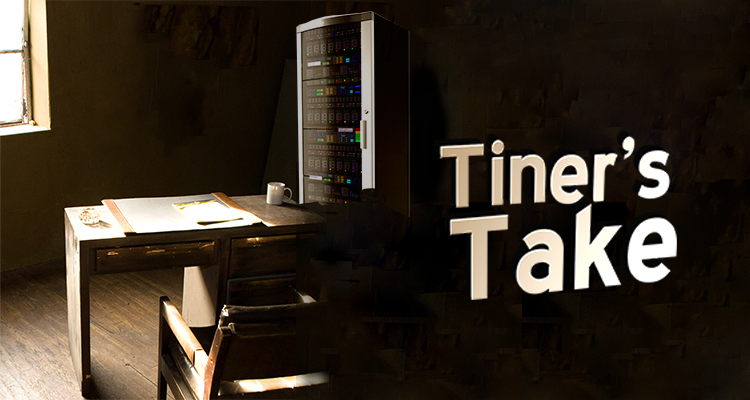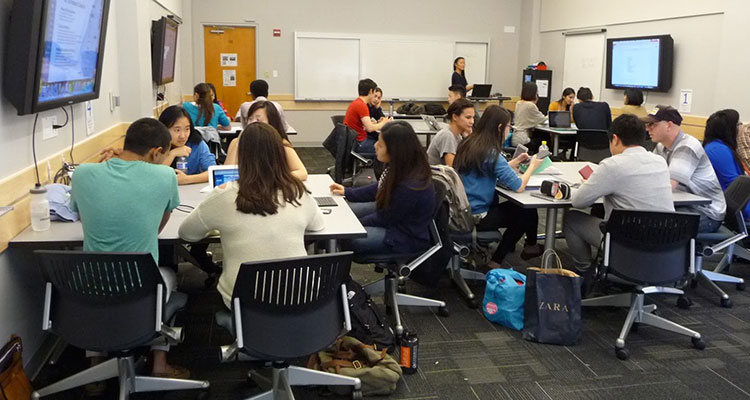Active Classrooms Demand New Thinking and Design

In May, Bates College announced that we would be building a new science building over the next couple of years. Many of us on campus have been working on this project for over a year. As the building promises to be an amazing addition to the college, it also presented an interesting change as I observed the design phase. More than ever, I got the sense that the faculty who would be using the classrooms in the building wanted to use technology, but also did not want the technology to get in the way.
We see this more and more in the popular active learning classrooms. Faculty are migrating to such rooms, but technology people (not just internal, but also designers and manufacturers) are struggling with the fact that the faculty don’t view technology as the most important part of the new classrooms. In fact, technology seems to be a necessary addition, but one that should not get in the way. This is a change from previous construction projects where faculty were willing to make concessions about room layout, in order to ensure the technology was in place. The concept of active learning is driven largely by flexibility. Table and chairs all need wheels, the walls are covered with writing surfaces and fixed equipment is frowned upon. For example, we have been challenged to eliminate the traditional podium in the room. This is a design struggle as we (and most other institutions) have long used a podium as the place where all the AV equipment is stored. Now, that equipment is moving back to a rack, and is not expected to be seen in the room, or take up any floor space.
 The walls are covered with whiteboards, and the faculty don’t want to give that up. The whiteboards allow easy collaboration between students in the room. It is this activity (moving, thinking, talking) that gives active learning its name and is the power behind it. What do we do about presentation capabilities in such a case? Wall mounted monitors tend to be ruled out, as they take away from the precious whiteboard space. Some of our designs are looking at smaller projections, with motorized screens. This allows us to leave the whiteboards in place, and give the option of digital display. The issue with this design is that the cost is driven up in the room significantly. Motorized screens and projectors cost more money than just a single LED mounted on the wall. Is the proper installation projectors that display directly onto the whiteboards? This would seem to solve many of the issues: Leave the whiteboard space and leave the whiteboards free from obstruction. It would also decrease the complexity of programming and use of the room. This approach would require careful consultation with potential users of the room. Primarily, potential users would need to be accepting to possible loss of image quality when moving from a direct view display to an image projected on a whiteboard. So far, I am hearing that this is acceptable, because in these rooms the faculty are viewing students (not technology) as the focal point.
The walls are covered with whiteboards, and the faculty don’t want to give that up. The whiteboards allow easy collaboration between students in the room. It is this activity (moving, thinking, talking) that gives active learning its name and is the power behind it. What do we do about presentation capabilities in such a case? Wall mounted monitors tend to be ruled out, as they take away from the precious whiteboard space. Some of our designs are looking at smaller projections, with motorized screens. This allows us to leave the whiteboards in place, and give the option of digital display. The issue with this design is that the cost is driven up in the room significantly. Motorized screens and projectors cost more money than just a single LED mounted on the wall. Is the proper installation projectors that display directly onto the whiteboards? This would seem to solve many of the issues: Leave the whiteboard space and leave the whiteboards free from obstruction. It would also decrease the complexity of programming and use of the room. This approach would require careful consultation with potential users of the room. Primarily, potential users would need to be accepting to possible loss of image quality when moving from a direct view display to an image projected on a whiteboard. So far, I am hearing that this is acceptable, because in these rooms the faculty are viewing students (not technology) as the focal point.
Computing is another issue that is a struggle for the new active learning rooms. IT has always been very happy setting up wired computer labs in rows. However, we are learning that these rooms do not provide an efficient service to classes. When we walk into a computer lab we often see the monitors flipped on their face, so that people in the room can see each other face to face. Also, the room provides for no flexibility due to the intense wiring of the room, and therefore the inability to move tables. The solution that non-technical people come up with for these problems is laptop carts. I refer to non-technical people, because I have never met a tech person who is in favor of laptop carts. We view them as unreliable and difficult to manage. However, we need to begin to adjust. Our customers (faculty, students and presenters) are demanding a different solution. Much like the image problem mentioned above, we need to move into areas that we are not comfortable with. We need to get together with our infrastructure teams and make sure that the wireless coverage in these spaces is robust. We need to work with our desktop operations team to ensure that there are solid solutions so that every time a laptop is booted, it starts quickly and is as reliable as a desktop computer. As AV people, we also need to understand how all of this works, because we are the ones who will be called into the room in an emergency. We need to become very familiar and comfortable with wireless technologies. Because of the need for flexibility, wires (including electrical) can not be run to the tables, as they would tie it in place.
All of these changes are why June is such an exciting month in our industry. It provides a combination of two excellent conferences. UBTech kicks off InfoComm week and gives you an opportunity to see others in the education world and hear what they may be doing to solve the problems. My suggestion is to find the sessions and the people who are looking at solving these problems in creative ways. Then, a couple days later you can visit the InfoComm show floor, and attend various sessions at InfoComm, to answer technical how to questions and find out about new products that can help solve problems.




